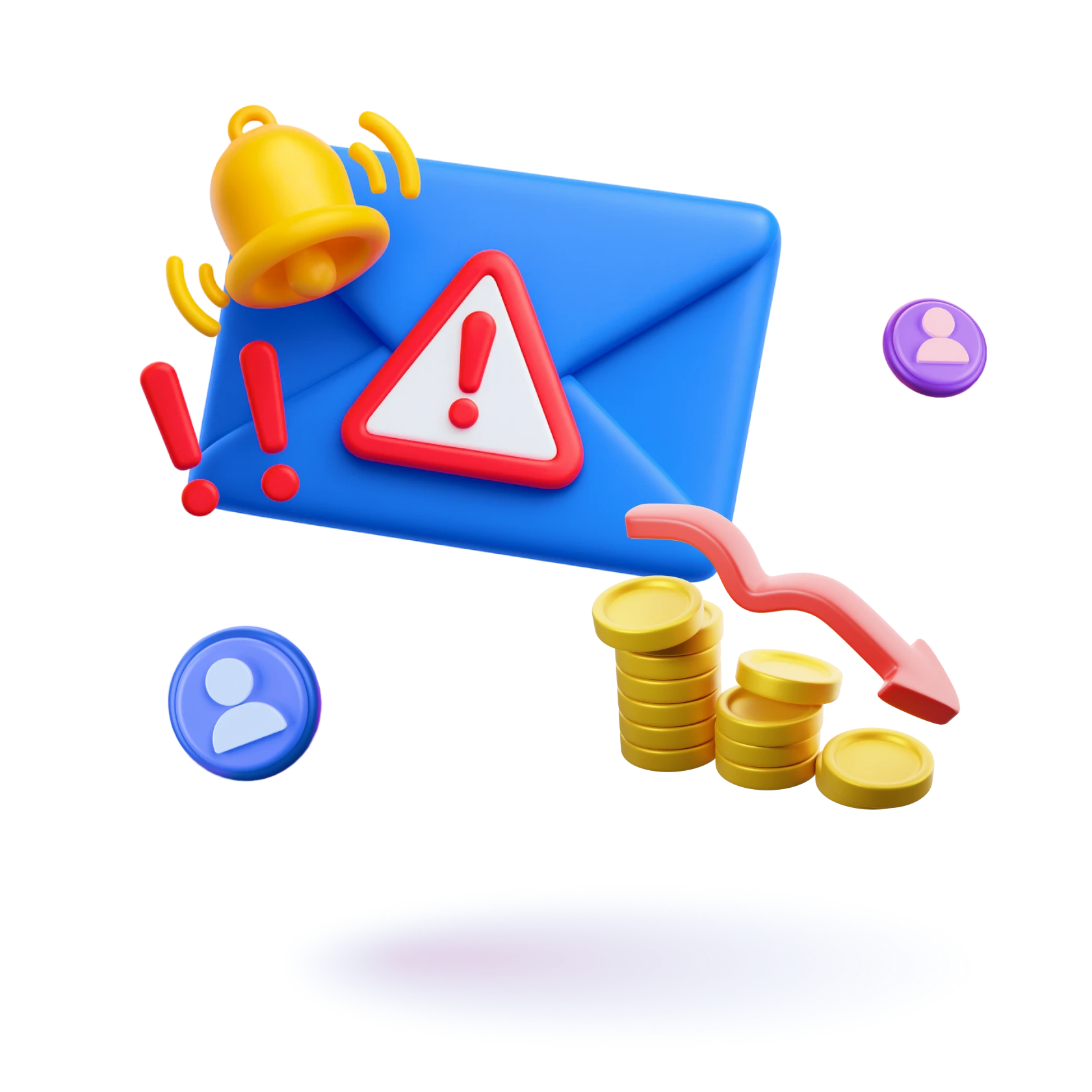70% of IT outsourcing companies fail to generate consistent results from cold email outreach campaigns.
That’s a painful number, especially for companies betting on outbound to crack new markets. If you’re offering IT services, software development, or system integration, you’re aware of the increasingly competitive market. Whether it’s email or LinkedIn, a well-structured cold outreach strategy remains one of the fastest and most cost-effective ways to build a predictable sales pipeline if done correctly.
Let’s talk about where most teams go wrong and how to fix it before your next campaign flops.
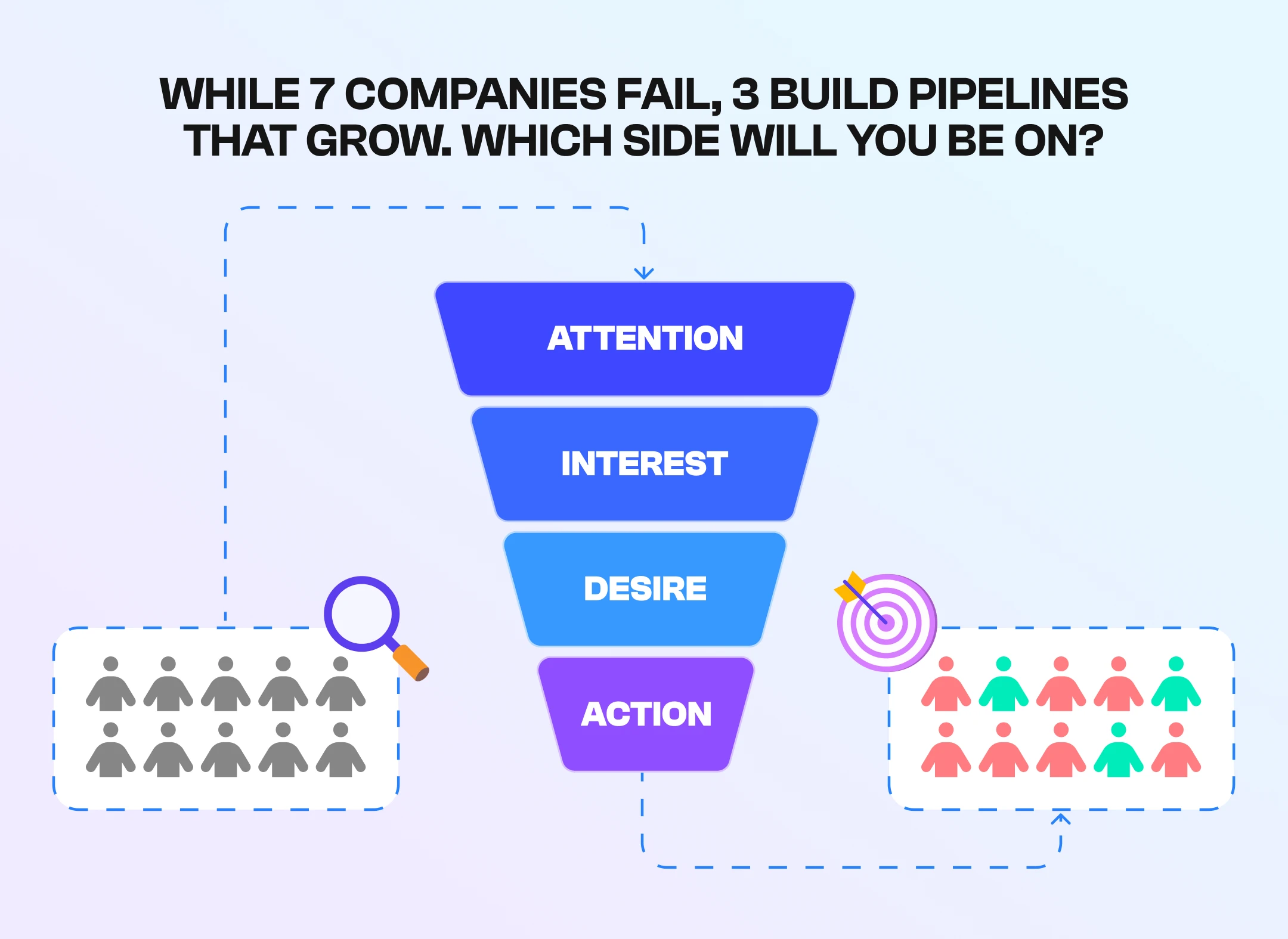
Why Cold Outreach Strategy Is Mission-Critical for IT Outsourcing Firms
Referrals and word of mouth are great, but they don’t scale forever. When your clients are scattered across the globe, you need a reliable way to reach beyond your local network. That’s where cold email outreach comes in: it enables IT outsourcing companies to connect with decision-makers in new markets without relying on chance introductions.
Sales cycles in IT services are notoriously long. Cold email outreach often serves as the first point of contact, planting the seed months before a deal is finalized. Without it, you’re stuck waiting for inbound leads that may never come. If you’re just starting to build a predictable pipeline, this beginner’s guide to B2B lead generation is a great place to start.
And let’s not forget the competition. Hundreds of outsourcing firms are already chasing the same clients, often with similar offers. If you’re not consistently showing up in inboxes or LinkedIn messages, someone else will. A consistent cold outreach strategy is what keeps your pipeline alive. Without it, growth stalls, and deals dry up.
Here’s why cold email outreach is mission-critical for IT outsourcing firms:
- Clients are global: Relying only on referrals limits reach; outreach scales prospecting across regions and industries.
- Sales cycles are long: Outreach provides early touchpoints that nurture prospects months before they’re ready to buy.
- Competition is fierce: With hundreds of outsourcing companies targeting the same market, standing out requires proactive engagement.
- The pipeline requires consistency: Without structured cold outreach, deal flow becomes unpredictable, making it more challenging to sustain revenue growth.
Top 5 Reasons IT Outsourcing Teams Fail Cold Outreach Campaigns
Most failed campaigns have the exact root causes. It’s rarely about the channel — the real issue lies in how teams approach targeting, messaging, and execution. Let’s break down the first big reason.
Poor ICP & Segmentation
Outreach without a well-defined Ideal Customer Profile (ICP) is like fishing without bait. You’re casting lines into the water, but nothing bites. Too many IT outsourcing teams fall into the trap of contacting “everyone,” thinking more volume equals more results. In reality, it just fills your pipeline with the wrong people.
Here’s what that looks like:
- Targeting industries where outsourcing isn’t common or relevant.
- Reaching out to executives who don’t feel the pain points you solve.
- Mixing regions with completely different buying behaviors and budgets.
- Pitching services to companies already fully staffed with in-house developers.
The outcome? Low open rates, weak replies, and wasted resources — all signs of a broken cold outreach strategy. Even worse, sending to the wrong audience damages your sender’s reputation, making it harder for the right prospects ever to see your emails.
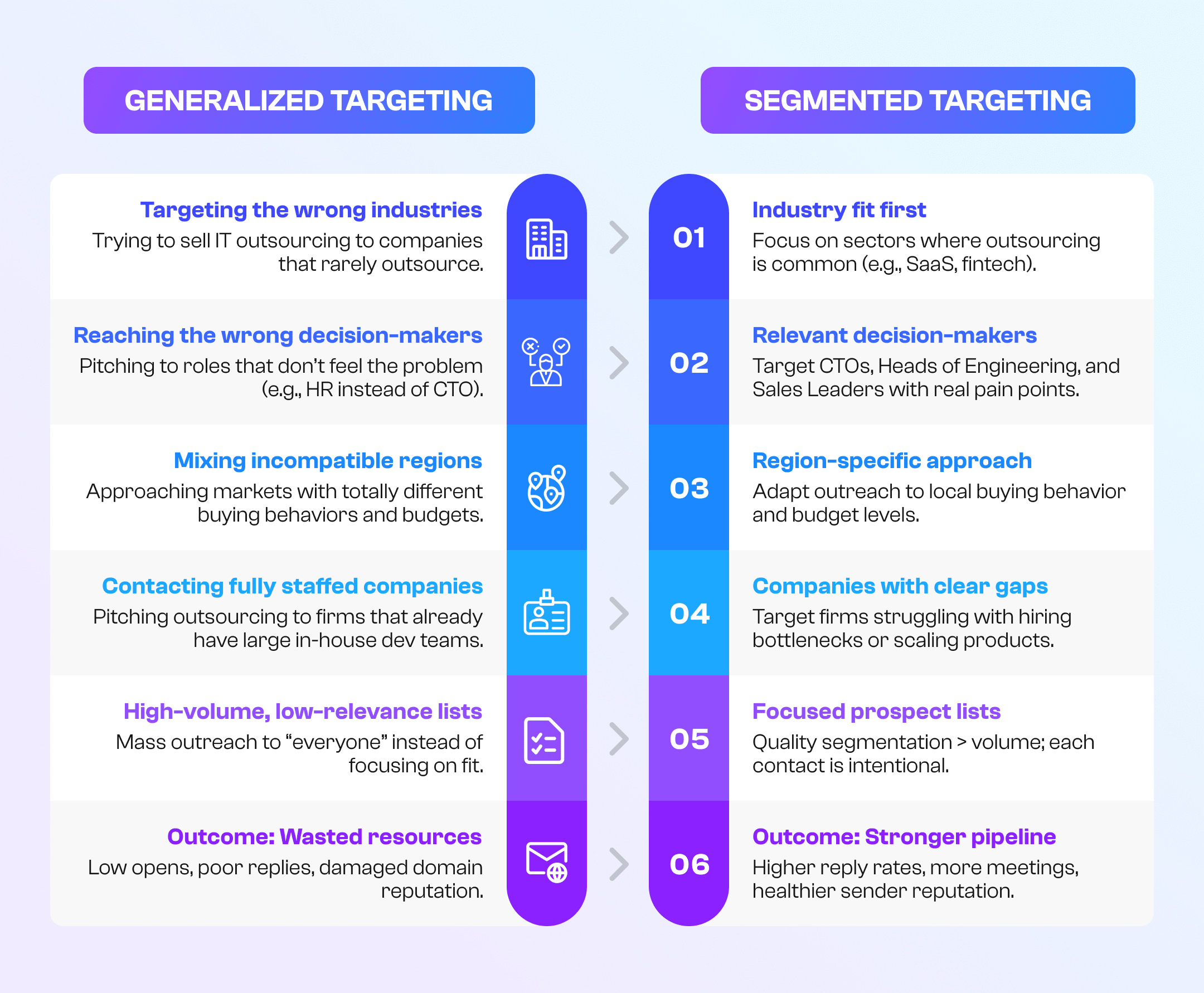
Weak Personalization & Messaging
Once the targeting is incorrect, the next significant failure arises from how the message is written. Too many IT outsourcing campaigns lean on generic templates that all sound the same. The classic opener: “We are an IT outsourcing company with 10+ years of experience…” — is so overused that most decision-makers stop reading after the first line.
Generic outreach creates two major problems:
- It blends in with the dozens of other pitches a prospect receives every week.
- It demonstrates a profound lack of understanding of the company’s actual challenges and priorities.
For decision-makers, that’s an instant turn-off. A VP of Engineering dealing with hiring bottlenecks doesn’t want a generic services pitch; they want someone who understands their stack, their growth stage, and their pressure points. If this feels familiar, you’re not alone — many sales teams run into the same wall, and we covered common traps in this guide on why lead generation efforts fail and how to fix them.
When messages don’t connect to the recipient’s reality — whether that’s the region they operate in, the tools they’re using, or the news about their recent funding — the result is silence. Without personalization, even the best cold outreach strategy turns into background noise instead of a conversation starter.
Example: Compare a bland opener like “We provide affordable developers” with something tailored: “Saw your team is scaling a React product. Many Series B SaaS companies struggle to hire fast enough locally. We helped a similar firm cut launch time by 30%.” One sparks interest, the other doesn’t.
Ignoring Deliverability
Even with a strong ICP and well-written copy, outreach falls flat if emails never reach the inbox. Deliverability is the hidden make-or-break factor that many IT outsourcing teams overlook. Instead of building a healthy sending infrastructure, they rush into campaigns and watch results crash without understanding why.
Common deliverability killers:
- No warm-up: Sending 200 emails on day one from a brand-new domain sets off instant spam alerts.
- High bounce rates: Outdated or scraped lists filled with invalid emails can damage a sender’s reputation quickly.
- Overloading one account: Pushing 300+ emails daily from a single inbox guarantees blacklisting.
- Missing authentication: Without SPF, DKIM, and DMARC, email providers treat your messages as suspicious.
- Inconsistent sending patterns: Random spikes in volume look unnatural and trigger filters.
When these issues pile up, domains get flagged, emails land in spam, and campaigns never even reach the decision-makers you worked so hard to identify. Teams often misdiagnose this as “outreach doesn’t work,” when the reality is that their cold outreach strategy is undermined by weak deliverability practices.
Why it matters for IT outsourcing firms:
With long sales cycles and fierce competition, missing just a few weeks of inbox placement can cripple pipeline growth. While competitors steadily build domain trust and stay visible, your emails disappear into spam, making recovery even more complicated.
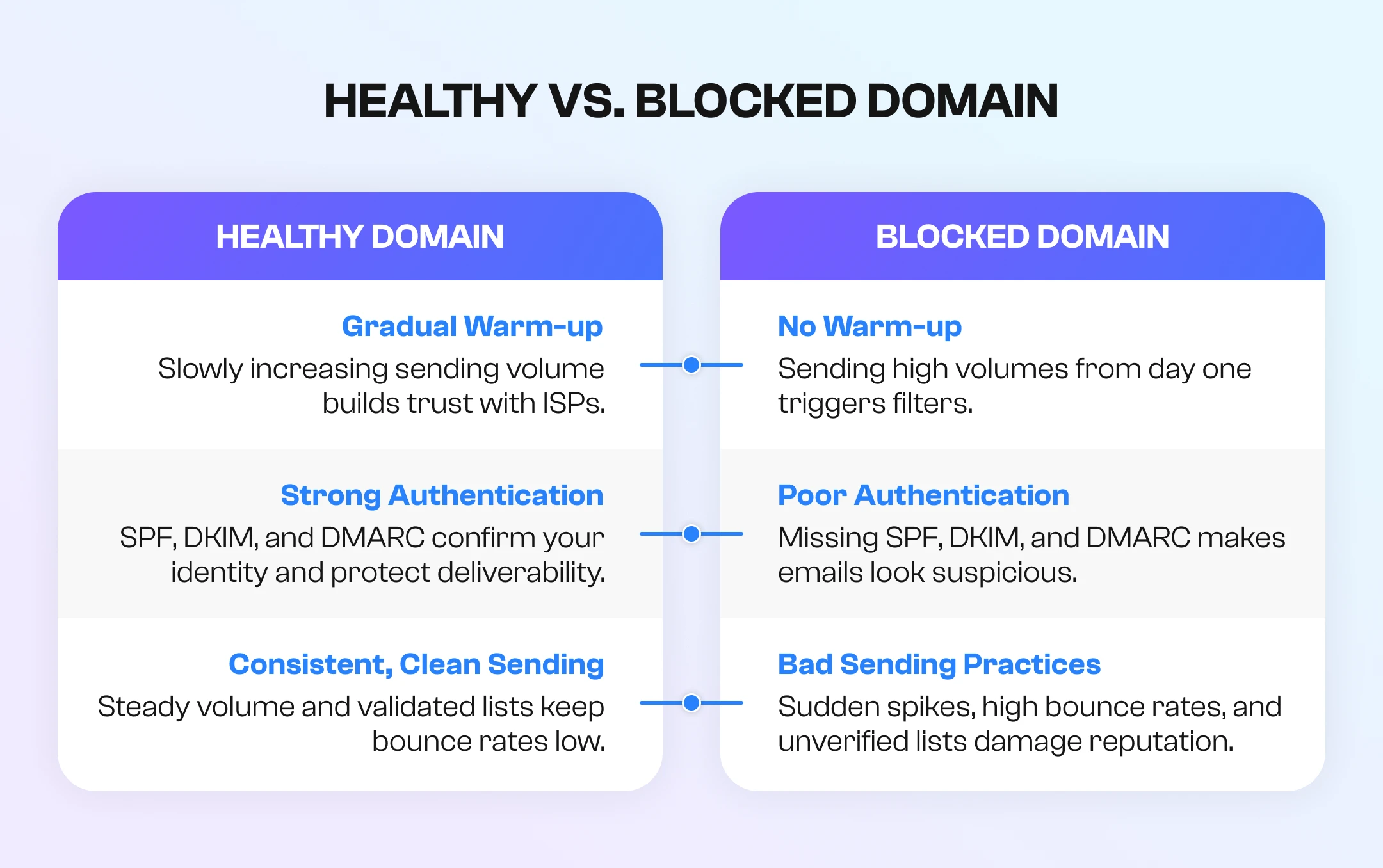
Wrong Metrics & Misalignment with Sales
Another big reason cold outreach fails is that teams track the wrong things. Many IT outsourcing campaigns boast about the number of emails sent or their high open rate, but those numbers don’t actually move the business forward. You don’t close deals from “emails sent.” You close deals from qualified conversations.
Signs of wrong metrics:
- Reporting on 5,000 emails sent instead of how many real decision-makers replied.
- Celebrating open rates while ignoring that most replies are “Not interested.”
- No clear definition of what counts as a sales-qualified appointment.
And even when replies do come in, lack of coordination with the sales team means leads fall through the cracks. Outreach books a call, sales doesn’t follow up on time, and the opportunity is gone. The disconnect makes the entire funnel less effective.
Many B2B teams confuse activity with progress, which is one of the biggest pitfalls of any cold outreach strategy. That’s why it helps to look at proven tactics that focus on outcomes, not vanity numbers. We’ve summarized some of the most effective B2B lead generation tactics.
Lack of Scale & Consistency
The final pitfall for most IT outsourcing teams is failing to maintain consistent cold outreach. Campaigns often start strong, but as soon as the team gets overloaded with client work or budgets shift, outreach slows down — and the pipeline dries up. A few weeks later, everyone scrambles to restart from zero.
This “stop-and-go” approach creates dangerous peaks and valleys: some months are flooded with new opportunities, others are empty. For industries with long sales cycles, such as IT outsourcing, those gaps can take months to recover from.
How this usually happens:
- Outreach relies on one or two SDRs who pause campaigns when they are busy.
- No structured process for prospecting and follow-up.
- Lack of automation to handle repetitive tasks like data enrichment or scheduling.
- No backup resources when the internal team shifts focus.
The result is unpredictable deal flow and a constant feeling of playing catch-up. Without a consistent rhythm, even the strongest cold outreach strategy can’t build a reliable sales pipeline.
Many companies facing this issue choose to partner with external experts — for example, Foxit worked with SalesAR to keep campaigns running continuously. Instead of pipeline gaps, they built a steady rhythm of qualified meetings that fueled long-term growth.
Want to see how that looked in practice? The Foxit case study shows how outsourced cold outreach can stabilize lead flow and prevent the peaks-and-valleys problem altogether.
When It Makes Sense to Outsource Cold Outreach
Not every IT outsourcing company needs to build a complete outreach machine in-house. For many, outsourcing their cold outreach strategy is a more effective approach, especially when speed, cost, and consistency are key considerations. Instead of hiring, training, and managing an entire SDR team, you can plug into a ready-made system that delivers results faster.
Here are the scenarios where outsourcing makes sense:
- Cost savings: Building an SDR team isn’t cheap. Salaries, tools, and training quickly add up, while outsourced cold email outreach gives predictable costs without the overhead.
- Scaling fast: If you’re entering a new market, you can’t afford a 6-month ramp-up. An external team already knows how to launch campaigns quickly.
- Pipeline stabilization: Even with a small internal sales team, outsourcing outreach ensures meetings flow consistently, avoiding the feast-or-famine cycle.
- Complement, not replace: External support works best alongside your sales team, freeing them to focus on closing deals instead of chasing leads.
We’ve seen these scenarios play out across multiple IT outsourcing firms — from companies validating new verticals to those expanding internationally. Case studies like Akridata and Weytec demonstrate how outsourcing enabled campaigns to move forward, stabilized the pipeline, and helped them grow faster than they could have with in-house efforts alone.
How to Build Outreach That Works
If most IT outsourcing campaigns fail because of sloppy targeting, weak messaging, or poor execution, then the solution is simple: flip the process on its head. A strong outreach framework is structured, repeatable, and aligned with sales goals. Here’s how to build one that actually works.
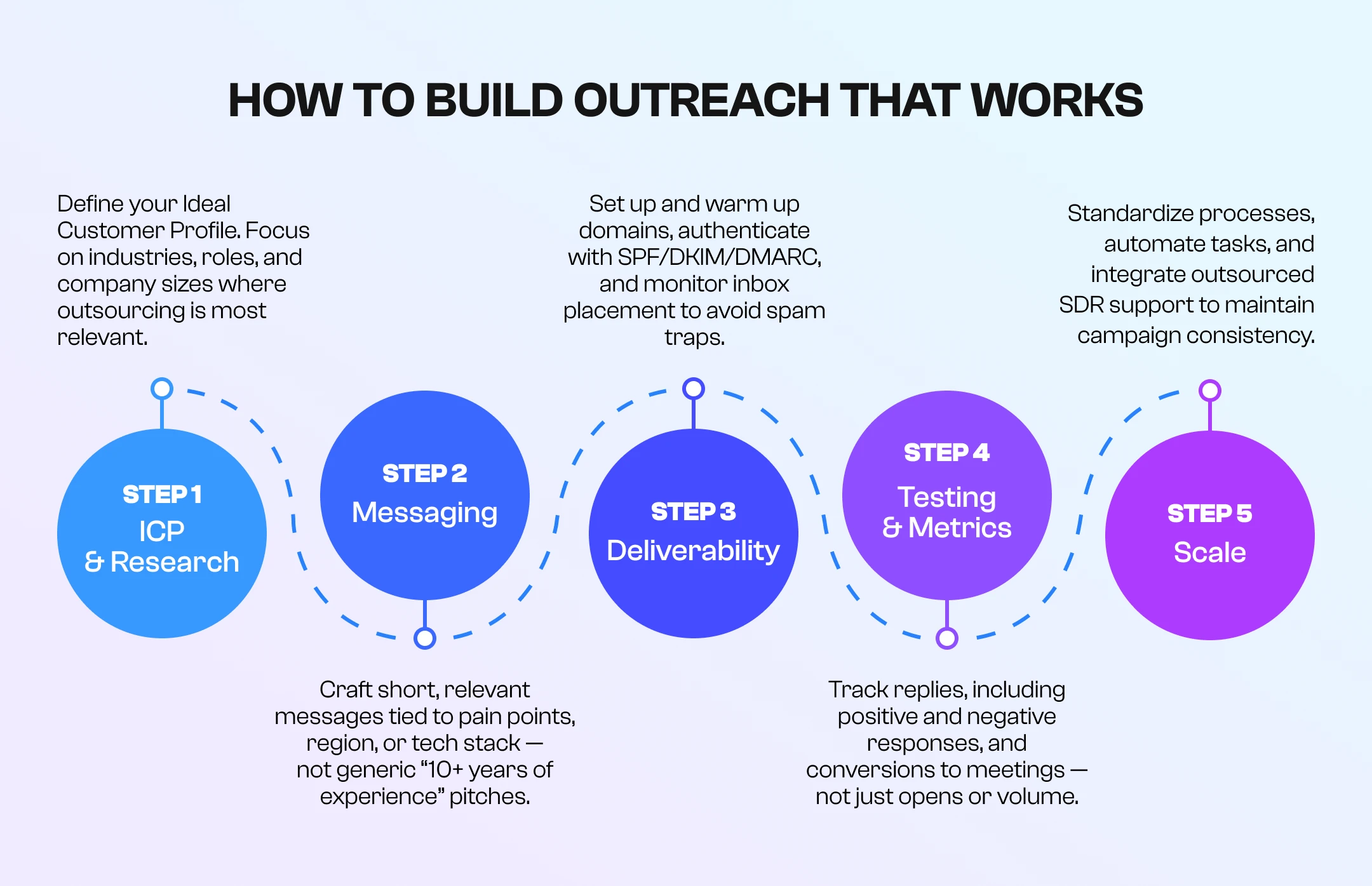
Step 1: ICP & Research
Everything starts with clarity on who you’re targeting. Instead of blasting emails to broad lists, narrow in on the people who can actually make a buying decision: CEOs, Founders, Chief Sales Officers, and Heads of Sales. These roles feel the pain of missed deadlines, high development costs, and stalled pipelines, making them much more likely to respond.
The more detailed your ICP, the stronger your results:
- Industries: Choose verticals where outsourcing is not just accepted but expected (fintech firms looking to scale products fast, healthcare providers needing compliance-ready solutions, logistics companies under pressure to digitize).
- Company size: Match your delivery capacity. A five-person startup may not afford your services, while a 5,000-person enterprise could drown you in procurement red tape.
- Buying signals: Look for triggers like funding announcements, recent hiring for tech roles, or product launches. These are signs they’re scaling and may need extra hands.
Why it matters: Outreach without a sharp ICP is guesswork. Every message sent to a poor-fit lead is wasted time, damages the domain’s reputation, and results in wasted effort. The sharper your ICP, the easier it is to connect with prospects who actually need what you offer, making each reply far more valuable.
Step 2: Messaging
Once you know who to reach, the next step is what to say. Messaging is where most IT outsourcing campaigns lose steam. Instead of context, many rely on the same cookie-cutter opener: “We are an IT outsourcing company with 10+ years of experience…” That signals you didn’t bother to understand the recipient.
If you’re struggling with tone, these practical email tips will help you avoid sounding generic:
- Mention their stack: “Noticed your team is hiring React engineers, we’ve helped similar SaaS companies scale without slowing product launches.”
- Reference their region: “Companies in DACH often struggle with finding .NET talent locally — here’s how we supported a client in Zurich.”
- Tie to challenges: Hiring bottlenecks, cost pressures, or delayed product rollouts are universal pain points. Show how you solve them.
- Keep it short: Three to five sentences max. Anything longer risks losing attention.
Why it matters: Decision-makers don’t have time for fluff. A message that shows relevance and timing earns attention, even if they’re not buying immediately. Done right, messaging opens the door to a conversation — and that’s all you need to move things forward.
Step 3: Deliverability
Even the best research and messaging won’t work if your emails never land in the inbox. Deliverability is the foundation of any outreach program, yet it’s often overlooked. Many IT outsourcing teams rush into campaigns without setting up domains properly, only to find their emails buried in spam.
What strong deliverability looks like:
- Domain setup: Utilize dedicated domains for outreach, ensuring SPF, DKIM, and DMARC records are correctly configured.
- Warm-up process: Start with small volumes and gradually increase sending to build trust with email providers. For scaling campaigns, using a reliable automation platform ensures consistency and keeps domains safe.
- Monitoring tools: Use platforms like GlockApps or MailTester to track placement, bounce rates, and sender reputation.
- Volume control: Avoid blasting hundreds of emails from a single inbox. Spread the load across accounts to stay safe.
Why it matters: If deliverability isn’t managed, prospects never even see your carefully written emails. Every spam flag damages your sender’s reputation, making it harder to recover later. Good deliverability protects your domain, ensures your outreach is read, and keeps campaigns sustainable in the long term.
Step 4: Testing & Metrics
Outreach isn’t a one-and-done activity. What works for one segment or message may flop for another. The only way to improve is by testing systematically and measuring the proper outcomes. Too many teams stop at vanity metrics instead of focusing on what truly drives revenue.
What to track and test:
- Reply rates: Not just opens, but how many prospects actually engage.
- Positive vs. negative replies: A “not interested” counts differently than a “let’s talk.”
- Conversion to meetings: How many replies turn into booked sales-qualified appointments?
- Message variations: Test subject lines, CTAs, personalization styles, and even the structure of your email sequence to see what resonates.
- Timing & cadence: Experiment with send times and follow-up frequency.
Why it matters: Outreach without testing is a matter of guesswork. Tracking only email volume or opens creates a false sense of success. By focusing on replies, conversions, and meetings, you get a clear view of whether your outreach is actually feeding the sales pipeline.
If you’d like to see how different channels perform under real-world conditions, this guide on the best B2B lead generation channels in 2025 is a helpful benchmark.
Step 5: Scale
Once the basics are in place, the next step is scaling. Many IT outsourcing firms stall here because outreach is often handled by one or two people who juggle too many responsibilities. As soon as client work ramps up, campaigns slow down, and the pipeline dries up.
What scaling the right way looks like:
- Documented processes: ICP research, messaging templates, and follow-up cadences should be standardized so that new team members can quickly integrate.
- Automation: Use tools for data enrichment, email sequencing, and reporting to cut manual work and keep campaigns running smoothly.
- Blended resources: Keep your in-house knowledge of products, client stories, and market expertise, but add outsourced SDR support when you need more volume or want to enter new regions.
- Consistent cadence: Cold email outreach isn’t seasonal. The goal is to maintain a steady rhythm that produces meetings on a weekly basis, rather than random spikes of activity.
Why it matters: By combining internal expertise with external support, IT outsourcing firms can grow their pipelines predictably without overloading their sales teams. This balance keeps momentum going even as markets shift or internal bandwidth gets tight.
Conclusion
Most IT outsourcing teams don’t fail at outreach because the channel is broken. They fail because the basics aren’t in place: poor ICPs, generic messaging, weak deliverability, vanity metrics, and inconsistent execution.
The solution is building a more innovative structure. That means refining who you target, writing relevant messages, protecting your domain health, measuring what matters, and keeping a steady cadence.
For many firms, outsourcing outreach is a shortcut to achieving this goal. It reduces costs compared to hiring a full SDR team, accelerates entry into new markets, and stabilizes the sales pipeline, allowing your internal team to focus on closing deals.

